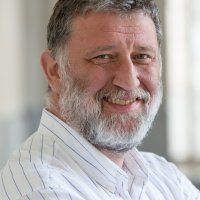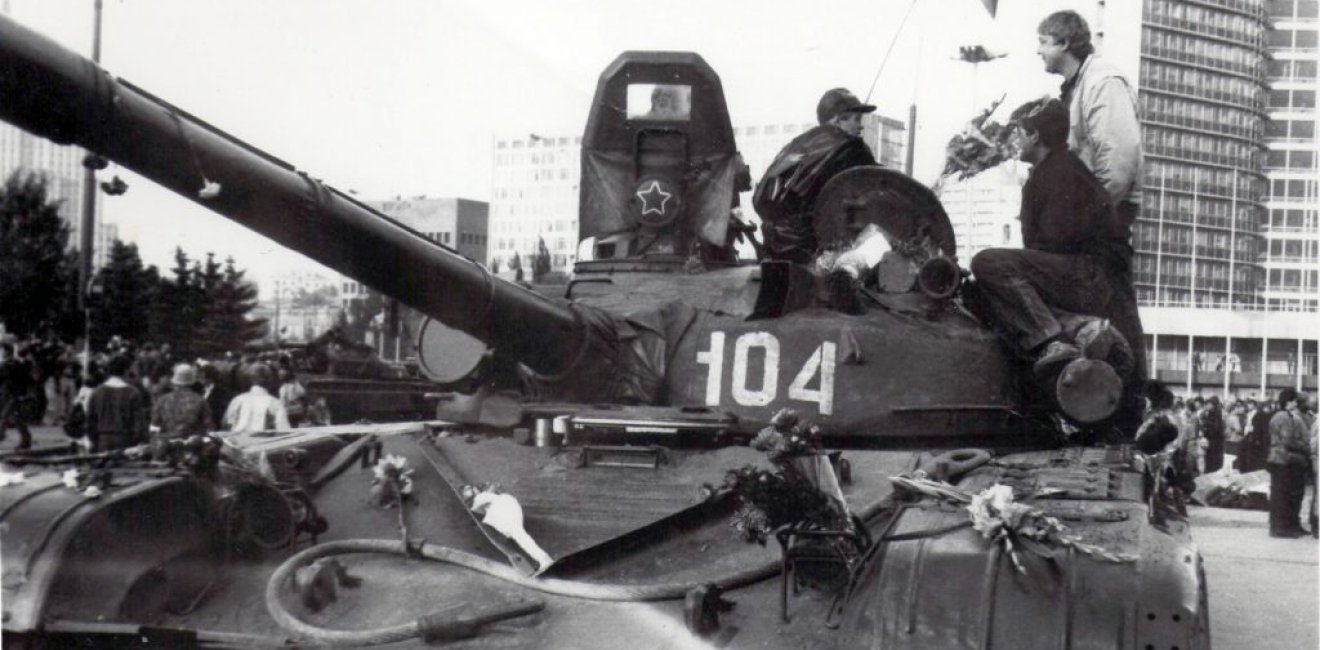
A blog of the Kennan Institute
BY SERGEY PARKHOMENKO
When I drive up to the monument for the three men who were killed during the 1991 August Coup in Moscow, a traffic cop stops me and orders me to drive around on a bypass.
Hardly an imposing sight, the monument stands over a car tunnel, at the crossroads of the capital’s two broad thoroughfares. Three protesters died in the tunnel below on August 21, 1991. They were in the vanguard of a crowd that surrounded and blocked the way of a convoy of armored vehicles, which everyone believed to be heading to storm the White House.
The Russian White House, the seat of the country’s government, is a grandiose structure on the banks of the Moskva River. Twenty-five years ago it housed the government of the Russian Soviet Federative Socialist Republic (RSFSR), the largest of the Soviet Union’s fifteen republics.
One can see three names – Dmitry Komar, Ilya Krichevsky, and Vladimir Usov – written in faint bronze paint on the dull gray marble of the strangely shaped pillar. There is a weatherworn, tricolor Russian flag waving at the top of a stubby pole next to it. The flag is replaced once a year at best, and by the end of each year it gets so frayed as to nearly lose its color and grow fringes along the edge.
This is the only monument to the events of August 1991, which in essence closed the chapter on the USSR. Those three summer days triggered the mechanism that finally dismantled the communist superpower and created conditions for the birth of the new Russian state.
On the 19th of August, 1991, the self-proclaimed State Committee on the State of Emergency, a group of hardline Party members opposed to President Mikhail Gorbachev’s reform efforts, announced his ousting in an attempted coup d’état. It became clear that the Soviet leader’s closest circle had betrayed him.
On the other hand, his most dangerous political rival, Boris Yeltsin, chose not to join the coup. Yeltsin had just been elected as President of the RSFSR and, in essence, the first president of a Russia that was yet to become independent. It was he who, in the preceding several years, had organized and taken charge of the anti-Gorbachev political opposition.
This time, however, he opposed the self-appointed committee, declared it illegal, ordered its leaders’ arrest, and took over the army and special forces. He delivered Gorbachev from a humiliating confinement at a presidential residence in Crimea and put him back in his Kremlin office.
However, the two presidents did not appear as victorious allies for too long. Russia emerged victorious from the events of that summer, and Boris Yeltsin had no intention of sharing that victory for the sake of saving Gorbachev and the USSR. From that August on, Russia began her unstoppable progress toward independence while the Soviet Union was approaching a collapse that became reality just a few short months later, in December 1991.
The two politicians, locked as they were in fierce competition, were driven by calculated political interest. One of them proved more energetic and cool-headed. Yet, it is clear today that the people who rallied around Yeltsin back then were acting on a very different set of values.
Tens of thousands of protesters occupied Moscow’s center and built barricades around the fortress of the White House. A new Russian power structure was being formed in real time, as a ring of people on those barricades shielded the emergent entity with their bodies. Those protesters were the ones who ensured the new state’s victory. The coup leaders did not have the nerve to use force against the unarmed but determined civilians.
The resistance action was not a well-planned or even particularly rational affair. Take, for instance, the people who blocked armored vehicles inside the tunnel near the White House at the height of the events. Why did they need to block exactly that convoy, and why in that tunnel?
Today’s dispassionate historian might think that the three young men died in vain. But the people in the tunnel knew exactly why they were prepared to die. Every single person in the crowd knew the answer, driven as they were by their commitment to freedom – a commitment that all of a sudden acquired an irresistible urgency for everyone involved.
“For freedom, ours and yours,” an old battle-cry born in the fight against tsarist autocracy and adopted decades later by the dissidents of the Khrushchev era, took on a simple and clear meaning once again. It was not just today’s freedom that the mendacious Soviet bureaucrats were taking away from everyone, but tomorrow’s freedom too. The attempt to reinstate the Soviet order was thus seen as degrading and insulting.
In those days, it did not occur to anyone to argue the nature of liberalism or compose liberal manifestos, and yet that crowd personified the triumph of the liberal idea in Russia. They saw freedom as the most important thing – it was the reason they joined the spontaneous movement.
Far from being a food riot, as some dismissively referred to it, the resistance to the putsch was a revolution that could, in all fairness, be called a revolution of dignity. This phrase, which today is associated with the 2013-2014 Maidan revolution in Ukraine, would be well fit to describe the August 1991 events in Russia.
***
August 21, 1991, is no doubt one of the greatest dates in Russian history, but now, twenty-five years later, I approach the place commemorating those events and run into a traffic cop. Pieces of asphalt and construction debris pile up around the monument, an open ditch runs nearby. The flag is missing from the pole.
Photo: The monument to the fallen in August 1991 stands over a tunnel at the crossroads of the capital's two broad thoroughfares. Photo credit: Sergey Parknomenko
The entire center of Moscow has succumbed to a reconstruction fever this year. Thousands of workers have turned the streets upside down, making the city barely inhabitable. Pedestrians are channeled off into narrow walkways next to the building walls. Cars squeeze between earthmovers and road rollers.
Supporters of trendy urban development blueprints clash on social networks with those who lament Moscow’s traditional identity and the vanishing coziness and humanity of their beloved old city. The chaos and grotesque gigantomania of this colossal construction project, many in Moscow believe, is a perfect environment for equally colossal abuse on the part of Moscow city officials and their contractors. Every day brings to light new allegations of corruption.
Muscovites care much more about all of this than about the forthcoming anniversary of great political events. The monument is buried under a pile of rubble and broken pipes, while the event itself is lost against the backdrop of a construction saga riddled with criminal schemes.
Photo: Construction near and around the monument to the fallen in August 1991. Photo credit: Sergey Parkhomenko
I personally cannot help but see a vivid historical and political metaphor here.
Every August, Russian commentators debate why those who successfully defended freedom against communist revanchists later surrendered it, with surprising indifference, to Putin’s authoritarianism with its attendant social contract of economic growth in exchange for political freedoms. Could there be a similarity in the way citizens of Russia chose to handle their freedom and the way Moscow residents are choosing to shape their city’s destiny?
To be sure, in today’s authoritarian Russia, public accountability mechanisms do not work and a state bureaucrat can easily afford to ignore the will of the voter. But even here, those in power – in this case the mayor of the Russian capital and his hierarchy of executives – still want to enlist some public support and secure the citizens’ gratitude.
The authorities thus come to rely on those who are interested in the practical aspects and amenities of urban living – on those who behave as consumers rather than voters. A population like this is easy to deal with. Moscow city authorities encourage the kind of matter-of-fact attitude toward public space that they themselves project by treating the city as a place of work, shopping and recreation. With such a one-dimensional, pragmatic attitude it is easier to evade public accountability and secure opportunities for abusing one’s power. The powers that be offer the average resident an easily graspable exchange: use the city as you would an armchair, get yourself comfortable in it, but don’t interfere with our designs – our plans are none of your business.
On the other hand, the authorities ignore or neutralize those who disagree with that attitude – those who have a more complex orientation toward the city, who treat it as a civilizational heirloom, a place of historical tradition, a unique cultural and spiritual abode. For those in power, these people are harmful and dangerous daydreamers who only disrupt social tranquility.
The fate of Russian freedom won in August 1991 has been kind of similar, hasn’t it? In the context of a superpower with its 250 million citizens, the White House defenders were but an insignificant bunch of idealists. But a high concentration of these people within the space of a few blocks around the Russian government building proved to be decisive. The failure of the putsch and the collapse of the Soviet system are a tipping point in the history of Russia: it all happened there, on this small patch. It was the super-centralized nature of power in the Soviet empire that made it possible. Yet these successes have faded in the interceding years, during which Putin’s social contract won out.
Despite the successful defense of Russian freedom in August 1991, it seems that the story of such “revolutions” is repeating itself time and again. A small community of dedicated and determined citizens attains victory, which then falls into the hands of the majority. In that moment, the nature of the revolution shifts from democratic to consumerist.
Revolution gives way to a long era governed by a deal that the majority of the population strikes with those in power. The deal is simple: unaccountability of those governing in exchange for the full stomach of those governed.
More often than not, the full stomach turns out to be an illusion, and the price of consumer pleasures, too high. But this becomes clear only much later – sometimes as late as twenty-five years down the road.
***
Just as the article was being prepared for publication, Moscow city government denied Muscovites’ request to hold a commemorative rally to honor the three men who died in August 1991 and lay flowers at the modest monument. The stated reason: ongoing maintenance and repair work.
Author

Journalist, publisher, organizer of civic projects

Kennan Institute
After more than 50 years as a vital part of the Wilson Center legacy, the Kennan Institute has become an independent think tank. You can find the current website for the Kennan Institute at kennaninstitute.org. Please look for future announcements about partnership activities between the Wilson Center and the Kennan Institute at Wilson Center Press Room. The Kennan Institute is the premier US center for advanced research on Eurasia and the oldest and largest regional program at the Woodrow Wilson International Center for Scholars. The Kennan Institute is committed to improving American understanding of Russia, Ukraine, Central Asia, the South Caucasus, and the surrounding region through research and exchange. Read more

Explore More in The Russia File
Browse The Russia File
Chechnya as a Model of Modern Russia

Russia’s Indigenous Communities and the War in Ukraine

Gas and Power in a Changing US–Russia Relationship

